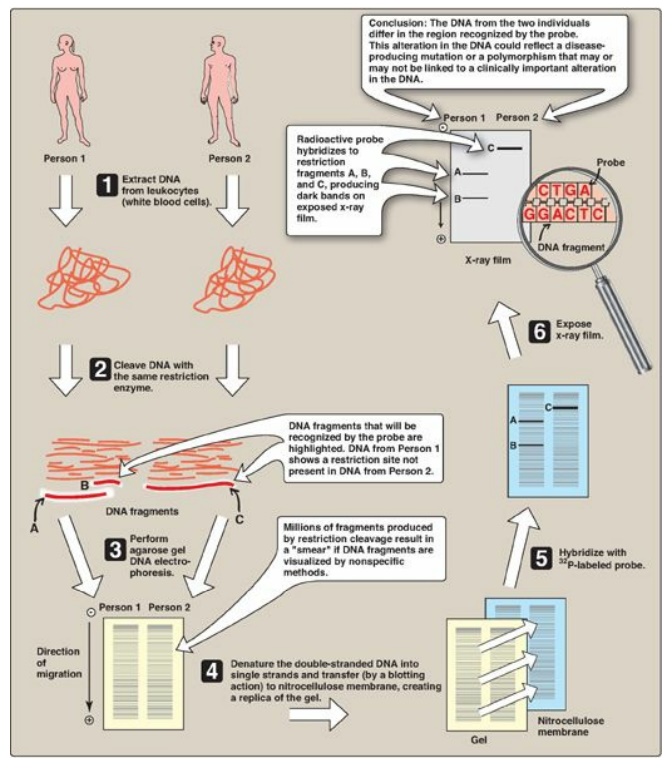Southern Blotting
| Home | | Biochemistry |Chapter: Biochemistry : Biotechnology and Human Disease
Southern blotting is a technique that combines the use of restriction enzymes, electrophoresis, and DNA probes to generate, separate, and detect pieces of DNA.
SOUTHERN BLOTTING
Southern blotting is a
technique that combines the use of restriction enzymes, electrophoresis, and
DNA probes to generate, separate, and detect pieces of DNA.

Figure 33.12 Southern blotting
procedure. [Note: Nonradiolabeled probes are now commonly used.]
A. Experimental procedure
This method, named
after its inventor, Edward Southern, involves the following steps (Figure
33.12). First, DNA is extracted from cells, for example, a patient’s
leukocytes. Second, the DNA is cleaved into many fragments using a restriction
enzyme. Third, the resulting fragments are separated on the basis of size by
electrophoresis. [Note: Because the large fragments move more slowly than the
smaller ones, the lengths of the fragments, usually expressed as the number of
base pairs, can be calculated from comparison of the position of the band relative
to standard fragments of known size.] The DNA fragments in the gel are
denatured and transferred (blotted) to a nitrocellulose membrane for analysis.
If the original DNA represents the individual’s entire genome, the enzymic
digest contains a million or more fragments. The gene of interest is on only
one (or a few if the gene itself was fragmented) of these pieces of DNA. If all
the DNA segments were visualized by a nonspecific technique, they would appear
as an unresolved blur of overlapping bands. To avoid this, the last step in
Southern blotting uses a probe to identify the DNA fragments of interest. The
patterns observed on Southern blot analysis depend both on the specific
restriction endonuclease and on the probe used to visualize the restriction fragments.
[Note: Variants of the Southern blot have been facetiously named “Northern”
(electrophoresis of mRNA followed by hybridization with a specific probe), and
“Western” (electrophoresis of protein followed by detection with an antibody
directed against the protein of interest), neither of which relates to anyone’s
name or to points of the compass.]
B. Detection of mutations
Southern blotting can
detect DNA mutations such as large insertions, deletions, or rearrangements of
nucleotides. It can also detect point mutations (replacement of one nucleotide
by another;) that cause the loss or gain of restriction sites. Such mutations
cause the pattern of bands to differ from those seen with a normal gene. Longer
fragments are generated if a restriction site is lost. For example, in Figure
33.12, Person 2 lacks a restriction site present in Person 1. Alternatively,
the point mutation may create a new cleavage site with the production of
shorter fragments. [Note: Most sequence differences at restriction sites are
harmless variations in the DNA.]
Related Topics
